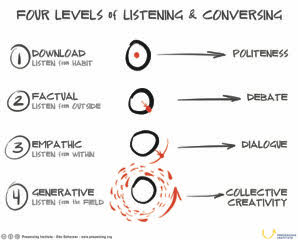See your part in the system you want to change
Boston College Professor Emeritus Bill Torbert once said, “If you’re not part of the problem, then you can’t be part of the solution.” That’s good news for those who want to make headway on complex problems. When you clearly see and acknowledge your part in the system you want to change, you begin to ask different kinds of questions. Instead of wondering why things are happening to you, you explore:
- How you have contributed to the current circumstances
- How your actions perpetuate the status quo
- How you need to change yourself to help spark needed change
Through systems mapping tools, you can gain a clear view of the system you want to shift. But in addition, according to the work of Otto Scharmer and Katrin Kaufer, perhaps the highest leverage lies in being willing to:
- Challenge your assumptions (opening the mind)
- Be vulnerable and truly hear others (opening the heart)
- Let go and see what is really needed and possible (opening the will)
As Peter Senge, Hal Hamilton, and John Kania say in “The Dawn of System Leadership,” “These three openings match the blind spots of most change efforts, which are often based on rigid assumptions and agendas and fail to see that transforming systems is ultimately about transforming relationships among people who shape those systems. Many otherwise well-intentioned change efforts fail because their leaders are unable or unwilling to embrace this simple truth.”
Through your openness to face your own biases, judgments, and fears, you begin to create a more accurate, more comprehensive view of the world than before. You also plant the seeds for the kinds of honest and productive collaborations that are instrumental for tackling systemic challenges.
Send us your recommendations for practices and tools.
Systems Mapping

A number of tools exist for “seeing systems,” ranging from simple hand-drawn clustering techniques to computer-based simulation models. At the core of all of these approaches is identifying different elements of a system and the interconnections between them. As you explore your role in the system or systems that are important to you by experimenting with various systems mapping tools, remember that even a pen-and-paper approach can provide you with important insights.
Systems Mapping
Connection Circles
Mental Models
The concept of mental models is invaluable for learning to identify—and then let go of—your deeply held assumptions. Peter Senge introduced this concept in The Fifth Discipline, where he defined mental models as “deeply held internal images of how the world works, images that limit us to familiar ways of thinking and acting. Very often, we are not consciously aware of our mental models or the effects they have on our behavior.” Two classic tools are especially useful for examining your own mental models so you can decide if they still serve you or need to be replaced.
Ladder of Inference: Developed by Harvard professor Chris Argyris, the Ladder of Inference is useful for noticing how quickly we jump from facts to assumptions. These mental “leaps up the ladder,” which are invisible to ourselves and others, then affect the actions we choose to take. Use this tool to surface and reflect on your own thinking and reasoning as you interact with others.

Ladder of Inference
Lefthand Column Exercise: Chris Aryris and Donald Schön developed the Lefthand Column Exercise for exploring how unspoken thoughts and feelings influence the outcome of conversations. You can use this technique to reflect on past conversations or prepare for future ones.
Lefthand Column Exercise
Presencing
Theory U, a framework and method for leading profound change developed by Otto Scharmer, offers perspectives and practices for tapping into the wisdom and experiences of others. By opening ourselves to engage with people in new ways, we “initiate a generative dialogue that allows for reflection, thinking together, and some sparks of collective creativity to happen.”
Four Levels of Listening: According to Scharmer, there are four levels of listening: Downloading, Factual Listening, Empathic Listening, and Generative Listening. By deepening the way you listen to others, you can better connect with what is going on now and with what is possible in the future.

Otto Scharmer on the four levels of listening
Dialogue Interviews
Dialogue Interviews are a tool for gathering perspectives from people from throughout a complex system. Reos Partners, a global consulting firm that uses this technique, describes them in this way: “Dialogue Interviews are in-depth conversations with concerned people throughout a complex system. Rarely do people feel so thoroughly heard. After conducting these conversations, we synthesize them and mirror them back, identifying common threads. The result is an unusually candid, reflective, and holistic assessment of the problem.”